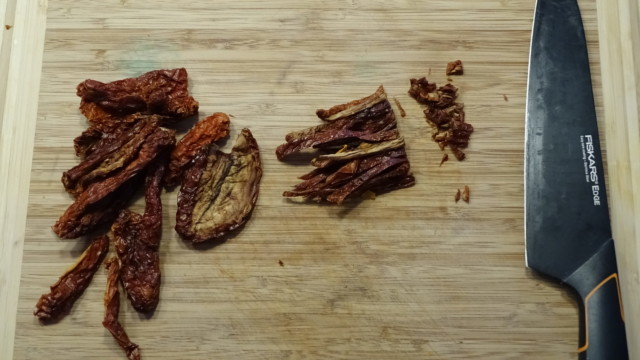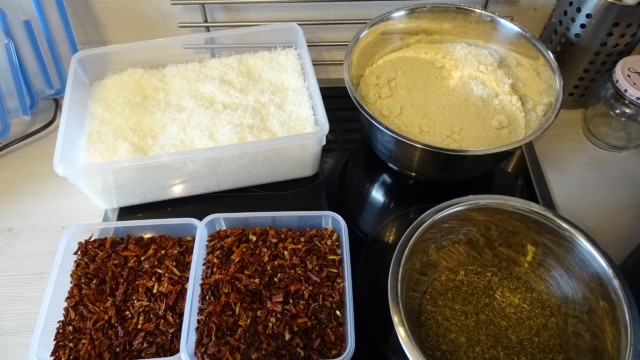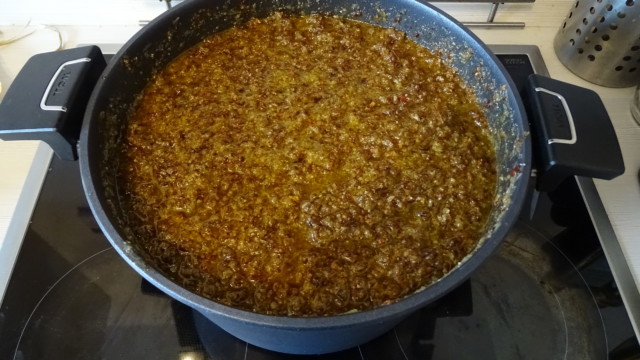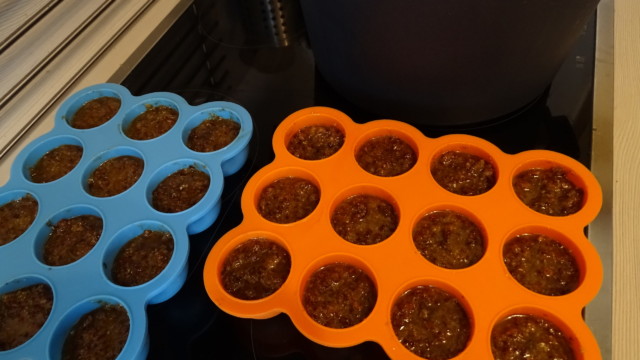Pasta sauce
Tuesday, 11. May 2021
I’m a big fan of pasta and pesto, and combining both into a delicious meal can easily make my day. But most manufacturers tend to deviate from the traditional recipes quite a bit. A good example is using cheap cashew nuts instead of pine nuts or almonds. The same goes for both cheese and oil used in the product, and there is a tendency towards a much higher amount of salt for flavour potentiation. But I’m a purist with those things, and I want my pesto to be what it says on the label. The only valid option short of moving to Italy is therefore, to make my own pesto using the correct ingredients in the correct amounts. Since pesto sauce is a very old tradition, there isn’t just one single recipe to go by. But there is a good estimate to what a specific pesto should contain, some of which is even backed by historical records as is the case with Pesto Genovese.
The trouble with making your own pesto is that it’s a very messy process, that includes a lot of oil and that can turn any kitchen into a battlefield. Since there is a considerable effort required for cleaning afterwards, I tend to create large amounts of pesto in one go, giving some to family and friends and storing some more in the freezer. So far, I’ve been making the three more famous pestos originating from Genoa, Sicily and Calabria, using the ingredients below.
Pesto Genovese
- 150 g of dried basil or 3 kg of fresh basil
- 1 kg of pine nuts
- 1 kg of Parmigiano-Reggiano
- 20 g of ground sea salt
- 10-20 garlic cloves
- ~6 l of extra virgin olive oil
Pesto alla Siciliana
- 2 kg of sun dried tomatoes
- 50 g of dried basil or 1 kg of fresh basil
- 1 kg of blanched almonds
- 1 kg of Pecorino Romano
- 10 garlic cloves
- ~6 l of extra virgin olive oil
Pesto alla Calabrese
- 1 kg of sun dried tomatoes
- 10 large bell peppers (5 red, 5 yellow)
- 2 hot chilli peppers (red)
- 50 g of dried basil or 1 kg of fresh basil
- 1 kg of blanched almonds
- 1 kg of Pecorino Romano
- 10 g of ground sea salt
- 10-20 g of ground black pepper
- 10-20 garlic cloves
- ~6 l of extra virgin olive oil
Preparation
The preparation is easy enough, but it can become quite time-consuming when dealing with larger quantities. Some ingredients are also a little tougher and require a bit of ingenuity or some hefty tooling. Tradition dictates that a mortar and pestle be used for grinding of the ingredients, but electric kitchen aids are a good replacement in modern times.
- I find fresh basil to be a rather hard to grind substance, and the contained water reduces the storage life of the resulting pesto considerably. Instead, I order dried basil on the internet in packs of 100-500 grams. The basil and some oil goes into a blender where it is chopped into tiny bits, giving the oil a dark green colour.
- Processing the nuts can be done using a blade grinder, that will chop them into a fine oily powder. Short and repeating bursts of roughly 5 seconds in length and regular breaks should be applied to keep the grinder from overheating.
- Sun dried tomatoes are tough enough to withstand even the heavy punishment of an ordinary electric blender. I cut them into small bits using a knife, before I use our blender and some oil to get down to the desired fineness. This manual step of chopping with a knife may be omitted, if you have access to a proper heavy-duty blender.
- The peppers are cut into slices and then put into the oven at 120 °C. They are done once the skin peels off on the edges, but this can take a while. Once all the skin is removed, the peppers can be blended with the rest of the ingredients.
- The garlic must be ground very fine and using a garlic press doesn’t quite cut it. I use a broad cooking knife and a wooden board to grind the cloves.
- The fineness of the grated cheese is responsible for the eventual texture of the pesto. There is no magic behind this, just use whatever hard cheese grater you have.
Some steps require the use of olive oil as a processing fluid in the blender. I tend to separate any excess oil after blending for use in the next blending phase, using a large sieve and a bowl. This is so that the amount of oil in the final pesto isn’t too great, and I manually add whatever oil is missing at the very end. This pesto can be stored for several months, as long as it’s kept covered with oil. I like to store it in glass jars in the fridge. In case of storing it in the freezer, it pays to split the volume into smaller chunks using silicon forms, for better handling. In the end, you should let the pesto steep for about a week. During this process, the entire mass will become a darker tone and the flavour of all the ingredients spreads into the oil.




